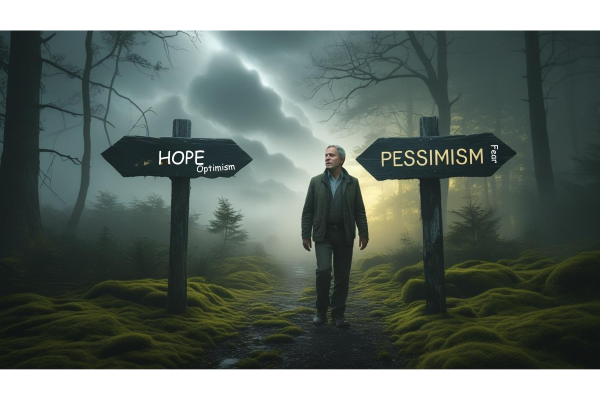If someone tells you:
“Be careful, things might fall apart soon…”
…you’re far more likely to believe them than someone who says:
“Don’t worry, things are going to get better.”
Why?
Because our brains are wired to trust bad news over good.
Morgan Housel, in his influential book “The Psychology of Money,” introduces a concept that perfectly explains this behaviour. It’s called the Seduction of Pessimism.
While Housel initially discussed it in the context of money and investing, this psychological pull manifests in every aspect of life—our careers, relationships, ambitions, and daily decisions.
This blog explores what the Seduction of Pessimism truly is, its impact on our thinking, and how we can overcome it to live braver, freer lives.
Table of Contents
1. What Is the Seduction of Pessimism?
The Seduction of Pessimism refers to our natural tendency to believe in bad outcomes more than good ones. It feels “smart” to prepare for the worst, while hoping for the best often feels naive or childish.
As Housel puts it:
“Pessimism isn’t just more common than optimism. It also sounds smarter.”
That’s the trap.
Pessimism sounds like wisdom. It makes us feel cautious, mature, and in control. But more often than not, it just makes us scared.
In reality, the Seduction of Pessimism convinces us that worrying is the same as being prepared—and that’s not always true.
2. Why We Trust Fear Over Hope

Let’s break down the science.
Our brains are built for survival. Thousands of years ago, if you ignored the sound of a tiger in the bushes, you might die. Therefore, the brain learns to prioritise danger.
That ancient instinct still operates today—except now the “tiger” might be:
- A difficult conversation
- A job interview
- A new relationship
- A life decision that feels risky
So when someone warns us of potential failure, our brain says, “Pay attention.”
But when someone encourages us with hope, our brain says, “Be careful.”
That’s how the Seduction of Pessimism quietly runs our inner world—convincing us that fear is smart and optimism is foolish.
3. The Strange Comfort of Worst-Case Thinking
Here’s the paradox: expecting bad things gives us a sense of emotional safety.
Why?
Because if something goes wrong and we expect it, we feel in control.
And if things go well, we’re “pleasantly surprised.”
This is the sneaky logic behind the Seduction of Pessimism:
- We rehearse failure in our minds so that it won’t hurt later.
- We assume disappointment, so joy feels like a bonus.
- We avoid hope because hope can be broken.
But in doing so, we end up living emotionally below zero—always bracing for impact, never entirely at peace.
4. Where Pessimism Shows Up in Everyday Life
The Seduction of Pessimism doesn’t only appear in crisis. It sneaks into our daily choices:
4.1 In Career Decisions
You want to switch jobs or start a project, but a voice inside says:
“What if it doesn’t work? What if I fail?”
So you stay stuck.
4.2 In Relationships
You’re afraid to open your heart, because:
“What if they leave? What if I get hurt again?”
So you keep your walls up.
4.3 In Personal Goals
You want to write, paint, travel, or speak your truth, but…
“What if no one cares? What if I’m not good enough?”
So your dreams stay dormant.
This is how the Seduction of Pessimism robs you of a life fully lived—quietly, and often without resistance.
5. What the Seduction of Pessimism Steals From Us
Let’s be brutally honest.
Pessimism feels smart. But it comes at a cost.
- Opportunities – You talk yourself out of them before you begin.
- Courage – You convince yourself it’s too risky to try.
- Presence – You’re so busy fearing tomorrow that you can’t enjoy today.
- Connection – You protect yourself from pain, but also from intimacy.
The Seduction of Pessimism doesn’t just guard you from disappointment.
It slowly drains joy, ambition, and freedom from your everyday life.
6. How to Break Free from Fear-Based Thinking
Escaping the Seduction of Pessimism doesn’t mean becoming unthinkingly positive.
It means finding a middle ground—a place where you can be cautious without being controlled by fear.
Here’s how:
6.1 Catch the Voice of Fear
When a thought like “What if I fail?” arises, pause. Ask:
“Is this fear warning me, or trying to paralyse me?”
Awareness is the first step.
6.2 Flip the Question
Instead of only asking “What if it goes wrong?”, also ask:
“What if it goes right?”
Let that possibility live in your mind, too.
6.3 Remember Your Strength
You’ve survived hard times. You’ve grown. You’ve adapted.
The fact that you’re here proves you’re capable.
Don’t let the Seduction of Pessimism erase that truth.
6.4 Surround Yourself with Hopeful People
Pessimism is contagious—but so is belief.
Spend time with people who lift your eyes toward possibility, not just precaution.
6.5 Celebrate Small Wins
Train your brain to notice progress.
Every tiny win—every brave moment—breaks the spell of pessimism.
7. The Power of Realistic Optimism
Optimism isn’t about ignoring problems.
It’s about choosing to believe that, despite the problems, good things can still happen.
This is the antidote to the Seduction of Pessimism.
Optimism says:
“Yes, things could go wrong. But they could also go right. And I’m willing to move forward anyway.”
It takes strength to hope.
It takes courage to try again.
It takes wisdom to believe in growth, even after loss.
And that’s what makes optimism powerful, not naive.
8. Final Thoughts: Hope Is Not Naivety
The Seduction of Pessimism will always be there, whispering in your ear, telling you to play it safe, stay small, and avoid hurt.
But you get to choose whether you listen.
Yes, life is unpredictable. Pain and setbacks are real.
But so is healing. So is joy. So is transformation.
You don’t have to deny reality to believe in a better future.
You have to believe that you have the power to respond to reality with strength and grace.
Hope is not foolish.
It’s fuel.
And it’s often the first step toward real change.
The next time you feel the Seduction of Pessimism creeping in, take a breath. Ask yourself:
“Is this fear protecting me, or preventing me?”
Then choose growth. Choose effort. Choose light. Because at the end of the day, a life led by fear is half a life.
And you deserve more than that.
Also read: Quadrant II Living: The Secret Weapon of Highly Effective People
Call to Action:
Have you struggled with fear-based thinking in your own life?
Share your experience in the comments below—your story might help someone else break free from the Seduction of Pessimism, too.


1 thought on “The Seduction of Pessimism: Why We Fear Hope and Trust Worry”